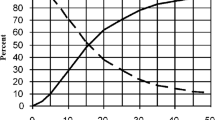Abstract
The study aims to present virtual prototyping applicability for design and evaluation of complex system of automotive industry. It presents a new principle design solution and illustrates design development, based entirely on virtual prototyping. The design concept is to provide solution for radiators fan and its shroud for high speeds when the fan acts like resistance. Multiple design variants are examined using virtual prototype of radiators, fan, shroud and all engine components. Developed design variants are compared by their performance both at low and high speeds.
Similar content being viewed by others
Keywords
1 Introduction
Computational fluid dynamics or CFD is the analysis of systems involving fluid flow, heat transfer and associated phenomena such as chemical reactions by means of computer-based simulation. The technique is very powerful and spans a wide range of industrial and non-industrial application areas [1, 2, 9, 10].
In the early years, the development of methods to numerically solve the equations of fluid dynamics, most research performed was of interest to the CFD community and was used mainly for research purposes. However, after a level of maturation of CFD numerical methods, practical applications of CFD analysis has been increased significantly last years because it is considered as a mature discipline now that can contribute considerably to the design, analysis and development of engineering systems involving fluid flows. CFD simulations provide insight into the details of how products and processes work, and allow new products to be evaluated in the computer, even before prototypes have been built. This is driven by the Virtual Prototyping (VP) ability to cut down developmental costs by minimizing physical testing [7] which can result in considerably reduced design cycle time and design costs [1, 2, 8].
The study aims to present CFD analyses and virtual prototyping applicability for design and evaluation of complex system of automotive industry. It should provide solution for the fan and its shroud for high speeds when the fan acts like resistance. When cooling components are combined to form a cooling package, it can be expected that interactions between the components will modify their flow resistance characteristics. Recent requirement for the motor fan of radiator cooling are the large air flow performance and electrical power consumption reduction. Large air flow is required mainly because of current increased application of downsized engines and diesel engines with large heat generation. On the other hand, reduction of electric power consumption for each component is a significant factor for enhancement of fuel and electric power consumption efficiency in HEVs and EVs driven by electricity [3, 4, 6].
The study shows complete process, starting with building the concept of physics, detailed review of virtual prototype itself, obtained results and comparison and their analysis. The major target is to obtain design with minimal resistance at all examined three drive velocities.
2 Concept of Physics
Main idea is to use an idealized model that contains examined components – shroud, fan and engine and inlet channel. The concept is shown on Fig. 1. Main target is to reach an optimal design and explore possibility to include openings that tends to increase fluid flow passing through motor space with minimal recirculation (bypass) flows. The study is carried out at 3 drive velocities: 10 km/h, 40 km/h and 240 km/h. Fan motor rotates at 2500 min−1 and is to be included by its pressure/fluid flow function. Thus, several ranges are to be covered [5].
Simulation results for different design variants will be compared by some major parameters that are tracked as mass flow rate through entire model (needs to be increased) and bypass (recirculation) through air guides (negative factor).
Input data includes detailed geometry models. These models need clean-up and simplification as to obtain input model suitable for CFD optimization. Some assumptions are defined as follows: simplified models of surrounding components (side covers and rear cover) are included as to present more accurate fluid flow boundaries; all components will be simplified maximally as to fasten and facilitate optimization process. For instance, the shroud is simplified as to facilitate computational model without decreasing significantly its accuracy. Major simplifications are performed over engine components. All assumptions are shown graphically on Fig. 2.
3 Virtual Prototype
The virtual prototype includes fluid volume only (all solid components are presented by their walls). CAD model of examined fluid area is shown on Fig. 3 as well as prepared mesh model.
Prepared model allows easy to implement various designs of the shroud. Examined 5 design variants are shown on Fig. 4.
The applied fluid flow boundary conditions are shown on Fig. 5. All models use velocity set on inlet – determined by incoming fluid flow. The fan is presented by its characteristic that is predefined by the manufacturer. The system is opened at the rear side where two outlets to atmosphere are defined.
4 Virtual Prototyping Results and Comparison
The virtual prototyping consists of 15 separate analyses performed in total and there is a large set of data to be considered. General overviews of obtained results are reported by fluid flow parameters presented by velocity vectors in vertical and horizontal planes. This is shown for all variants, for 10 km/h speed of incoming fluid flow, on Fig. 6.
All engineering analyses over four variants for shroud openings as well as initial (NO AIRGUIDE) design are presented also by the next parameters:
-
Total mass flow rate (in kg/s) – represents fluid flow through entire model and is measured on its inlet;
-
Mass flow rate through air guides;
-
Pressure drop for entire system.
These parameters are sorted out in Table 1 for each of examined design variants.
5 Results Analysis
Initially, the presented in results are shown as graphics on Fig. 7 to allow easy comparison and to illustrate next major conclusions concerning examined variants V1 to V4 (V0 – the initial design – is not considered of interest):
-
Variant V2:
-
This variant has maximal opening of air guides, resulting in about 8% increase of fluid flow @ 240 km/h. It shows maximal bypass @ 10 km/h – nearly two times more than V1 and V3 – which is negative. It also shows bypassing @ 40 km/h;
-
This variant has max pressure drop for lower velocities (10 km/h and 40 km/h);
-
Its overall performance is worst;
-
-
Variant V1:
-
Shows better performance, when comparing to V2 @ 10 km/h and @ 40 km/h, but it is worse @ 10 km/h, when comparing to V3;
-
Its total mass flow is lower than V3 @ 10 km/h and @ 40 km/h, and it has higher pressure drop @ 40 km/h and @240 km/h compared to V3;
-
-
Variant V3:
-
It has the second performance among examined variants, when comparing them @ 10 km/h, and it shows higher fluid flow compared to V1 and V4;
-
It has also best performance as pressure drop;
-
-
Variant V4:
-
It has best performance among examined variants, when comparing them @ 10 km/h – about 1/3 bypassing, in comparison to fully opened variant V2;
-
Has worst total mass flow among examined variants, except @ 10 km/h;
-
-
General conclusions:
-
Variant V3 has increased total fluid flow, compared to shroud without air guides (variant V0) and it has decreased overall pressure drop;
-
Bypassing is mainly due to the under pressure before fan, which causes recirculation. Variant V4 shows minimal bypassing, but it still exists. Air guide shape does not influence bypassing;
-
Overall performance of variant V3 shows its optimal balance.
-
6 Conclusion
A complex system of automotive industry - car fan and shroud – is studied in detail as to obtain a principally new design. Especially, a new design of the shroud is searched that will allow optimal engine cooling at low and high speeds. Design development is based entirely on virtual prototyping. Five different designs are compared on the basis of performed 15 numerical analyses. These design variants are compared by their performance both at low and high speeds, to select optimal solution.
Presented study is a good demonstration of the possibilities to use virtual prototyping at early design stage. Detailed information about various physical parameters allows the designer to change design in proper way, to generate new, better variants and finally – to reach optimal design. This example demonstrates virtual prototyping strength to give information for internal design parameters that remains “invisible” in physical prototyping.
References
Andersson, B., et al.: Computational Fluid Dynamics for Engineers, 1st edn. Cambridge University Press, Cambridge (2012)
Versteeg, H.K., Malalasekera, W.: An Introduction to Computational Fluid Dynamics, 2nd edn. Pearson Education Limited, Glasgow (2007)
Ishikawa, M., Otsuki, Y.: Efficiency improvement of motor fan for cooling radiator. Calsonic Kansei Tech. Rev. (11), 32–38 (2014)
Genov, J., Kralov, I.: BEM theory adaptation taking into account the wind speed vertical gradient for wind turbines of high class part 2 numerical analysis of the aerodynamic interaction. In: AIP Conference Proceedings, vol. 2048, p. 020016 (2018)
Malakov, I., Zaharinov, V., Tzenov, V.: Size RANGES OPTImization. Procedia Eng. 100, 791–800 (2015). ISSN 1877-7058
Mitov, Al., Kralev, J., Angelov, Il.: Investigation of model-based tuning of PI regulator for electrohydraulic steering system. In: The 9th International Congress on Ultra-Modern Telecommunications and Control Systems (ICUMT), Germany (2017). ISSN 2157-023X
Atanasov, V., Kovatchev, G.: Study of the cutting power in longitudinal milling of oak wood. In: 29th International Conference on Wood Science and Technology, ICWST 2018: Implementation of Wood Science – Proceedings, pp. 27–34 (2018). ISBN: 978-953292059-8
Tonchev, K., Balabanov, G., Manolova, A., Poulkov, V.: Personalized and intelligent sleep and mood estimation modules with web based user interface for improving quality of life. In: Arai, K., Kapoor, S., Bhatia, R. (eds.) SAI 2018. AISC, vol. 858, pp. 922–935. Springer, Cham (2019). https://doi.org/10.1007/978-3-030-01174-1_71
Todorov, G., Sofronov, Y., Petkov, A.: Innovative joystick virtual prototype ergonomy validation methodology by physical 3D printed functional model. In: International Conference on High Technology for Sustainable Development, HiTech 2018 – Proceedings, Article number 8566241 (2018). ISBN: 978-153867039-2
Todorov, T., Nikolov, N., Todorov, G., Ralev, Y.: Modelling and investigation of a hybrid thermal energy harvester. In: MATEC Web of Conferences, vol. 148, Article number 12002 (2018). ISSN: 2261236X
Acknowledgment
This work was supported by the European Regional Development Fund within the Operational Programme “Science and Education for Smart Growth 2014–2020” under the Project CoE “National center of mechatronics and clean technologies “BG05M2OP001-1.001-0008- C01.
Author information
Authors and Affiliations
Corresponding author
Editor information
Editors and Affiliations
Rights and permissions
Copyright information
© 2019 ICST Institute for Computer Sciences, Social Informatics and Telecommunications Engineering
About this paper
Cite this paper
Kamberov, K., Zlatev, B., Todorov, T. (2019). Design Development of a Car Fan Shroud Based on Virtual Prototypes. In: Poulkov, V. (eds) Future Access Enablers for Ubiquitous and Intelligent Infrastructures. FABULOUS 2019. Lecture Notes of the Institute for Computer Sciences, Social Informatics and Telecommunications Engineering, vol 283. Springer, Cham. https://doi.org/10.1007/978-3-030-23976-3_27
Download citation
DOI: https://doi.org/10.1007/978-3-030-23976-3_27
Published:
Publisher Name: Springer, Cham
Print ISBN: 978-3-030-23975-6
Online ISBN: 978-3-030-23976-3
eBook Packages: Computer ScienceComputer Science (R0)











